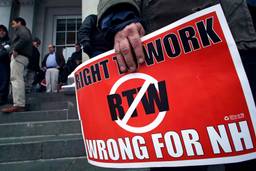MILWAUKEE — Labor Day 2011 was marked by high spirits and huge crowds in Wisconsin. In Madison, guitarist Tom Morello (of the band Rage Against the Machine) was welcomed back for a high-powered concert where he displayed the same spirit of solidarity that brought him to the city earlier this year.
Morello, who plays solo under the name The Nighwatcheman, was incongruously honored with a bag-pipe salute from International Association of Firefighters Local 311, a greeting that was emblematic of the kind of merging of diverse cultural and political styles that has kept the ongoing Wisconsin Rebellion rolling.
In Wausau, workers heartily booed anti-worker elected officials U.S. Rep. Sean Duffy and State Sen. Pam Galloway, both Republican Tea Party supporters, when they appeared at the Labor Day parade in this hard-hit central Wisconsin city. And in Milwaukee, the annual Labor Fest along the shore of Lake Michigan was even more packed than usual, with members of different unionists clad in a rainbow of T-shirts emblazoned with their union logo and a message of solidarity.
Along with the huge contingents of unionists, a mélange of progressive cultural projects put on a dazzling display of activity by the city’s multiracial youth: young Latinos and Latinas in feathered Mayan costumes dancing along the street, giant puppets depicting corporate greed and civil rights and labor heroes, and colorful floats with pro-labor messages.
But a keen awareness of labor’s plight nationally and in Wisconsin was never far from the minds of those attending. People with clipboards were surrounded by unionists eager to sign petitions calling for the recall of Gov. Scott Walker, the driving force behind imposing the state’s new virtual ban on public-employee unionism.
The very grim national economic picture was laid out quite compellingly by former Labor Secretary Robert Reich, whose New York Times essay drove home several especially worthwhile points. Reich astutely noted:
It’s no mere coincidence that over the last century the top earners’ share of the national’s total income peaked in 1928 and 2007 — the two years just preceding the biggest downturns.
As Reich points out: “The 5% of Americans with the highest incomes now account for 37% of all consumer purchases,” says Moody Analytics. Thus sales of luxury goods and cars are very strong. Meanwhile middle-tier chains like Kohl’s and JC Penney’s slump and even downscale chains like Wal-Mart and Dollar Stores are also limping along because their usual customers are losing spending power as employers slash wages.”
The spending power of middle-class and poor America has been further undermined by attacks on public-sector spending, which reflects a massive reallocation of funds from public services and workers to corporate tax cuts, as in Wisconsin, Florida, New Jersey, Michigan, and other states. A dismal rise of 17,000 in the number of private-sector jobs in the US (a monthly increase of 150,000 is required simply to keep pace with population growth) was negated by the loss of 20,000 government jobs in August.
At the state level in Wisconsin, the political rebellion against Gov. Scott Walker and his hard-line allies continued this summer with the unseating of two Republican senators in recall elections who voted for Walker’s bill effectively crippling public-employees unions. “We are Wisconsin,” which views itself as an independent political vehicle for workers, was the central force building up new political operations in six GOP Senate districts where none existed before.
A brave new world for Wisconsin labor
The labor-led coalition also figures to be a major force this fall as localities discover the impact of Walker’s cuts in public services. But public employee unions are now faced with the challenge of fighting for their members’ interests without the usual flow of dues streaming in, as Walker’s Act 10 banned the use of the dues check off. Nor do the unions even formally represent their members any longer, as Act 10 also established that the unions pay for annual re-certification elections that require 51 percent of the entire bargaining unit –not just those voting — to win representation rights.
Neither Walker nor his allies won election with 51 percent of the entire voting population, but this is the unfair standard that they have imposed for public-sector unions.
As University of Wisconsin history Prof. William P. Jones explained:
The law makes the certification process extremely difficult, It’s a pretty difficult bar. And there is not much the unions can deliver if they get that certification. They can only negotiate over wages, and they are capped at the consumer price index. I think it will be interesting how this plays out over the next few years. We will see more activity from unions, but what they gain from that, I’m skeptical.
This leaves the public-sector unions with the crucial task of showing their members how they can still act collectively and effectively (e.g., refusing overtime, refusing tasks not explicitly outlined in their work descriptions, filing civil service grievances) to protect their rights and pressure the state to yield on their bargaining rights.
Wisconsin’s militant public-sector unions continue to venture into their state’s challenging new anti-union environment. This Labor Day, it seemed like the public was behind them.

I hope you found this article important. Before you leave, I want to ask you to consider supporting our work with a donation. In These Times needs readers like you to help sustain our mission. We don’t depend on—or want—corporate advertising or deep-pocketed billionaires to fund our journalism. We’re supported by you, the reader, so we can focus on covering the issues that matter most to the progressive movement without fear or compromise.
Our work isn’t hidden behind a paywall because of people like you who support our journalism. We want to keep it that way. If you value the work we do and the movements we cover, please consider donating to In These Times.







